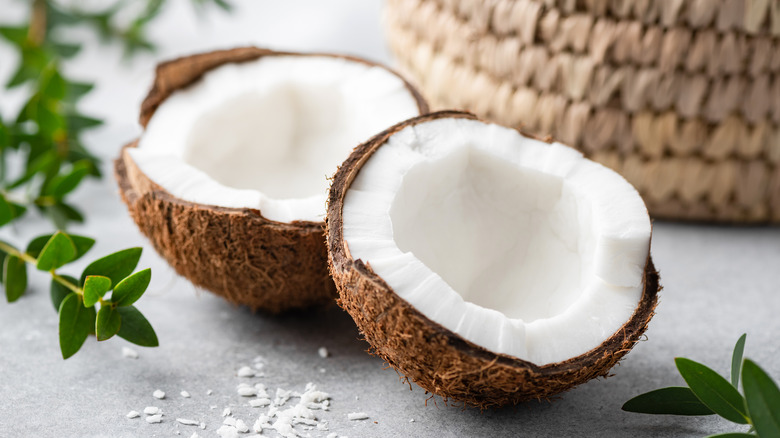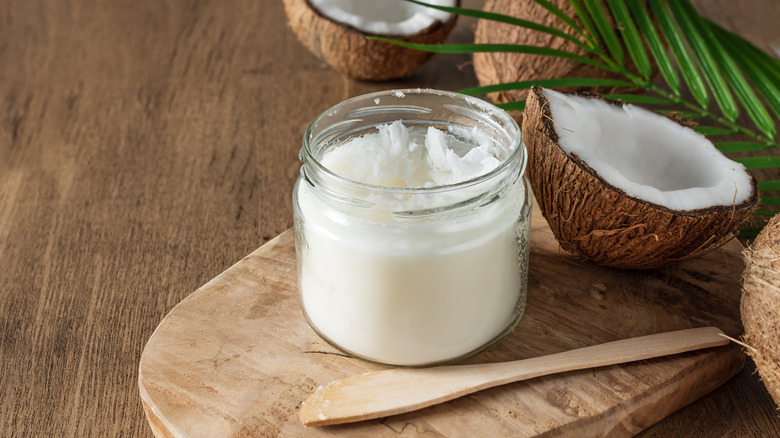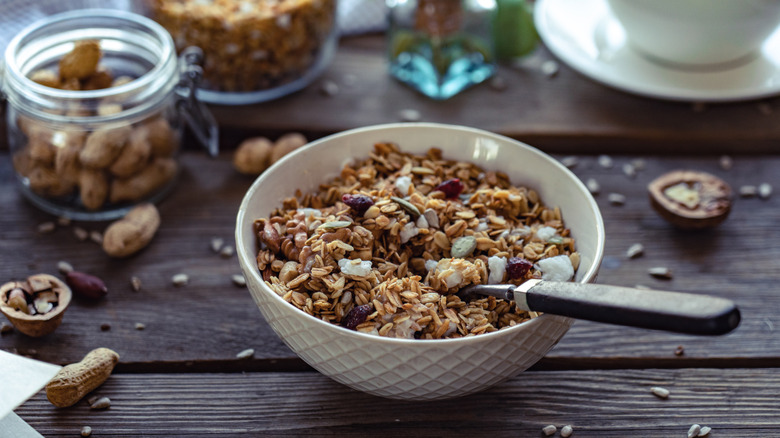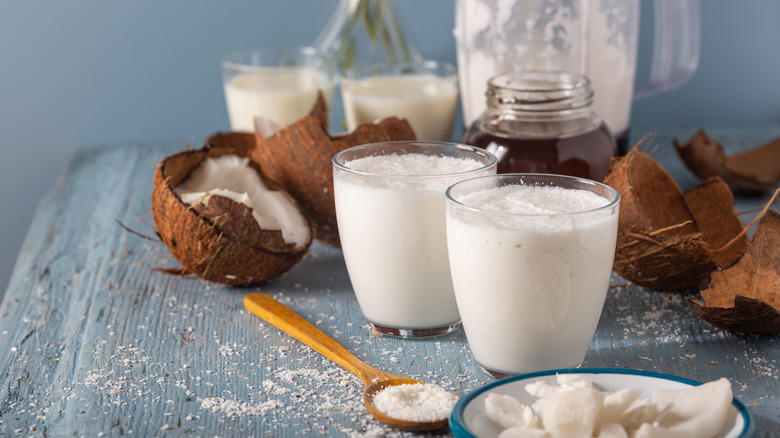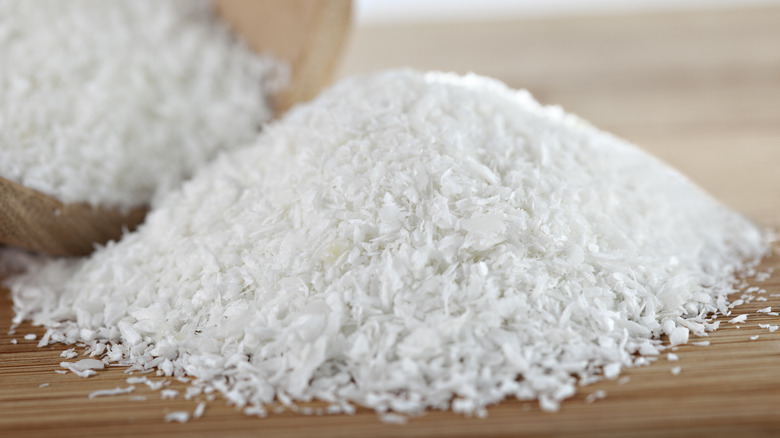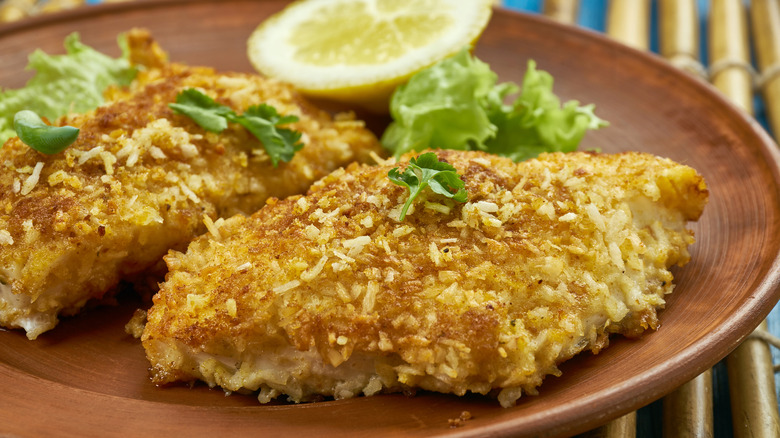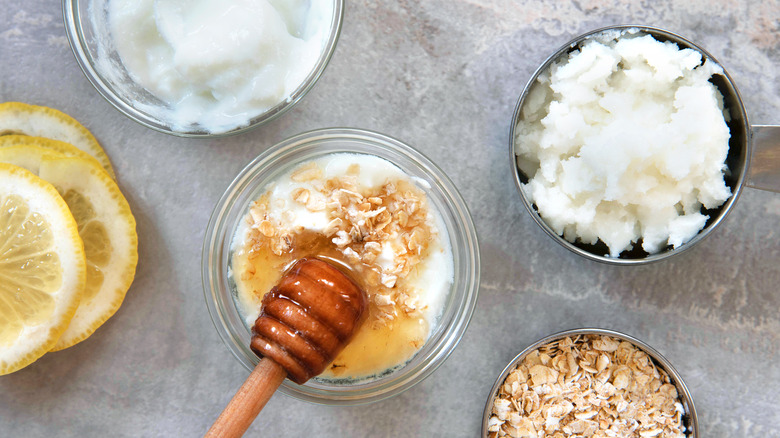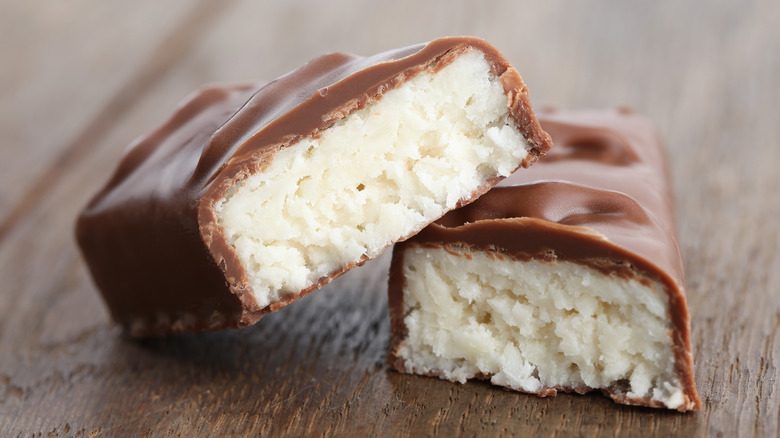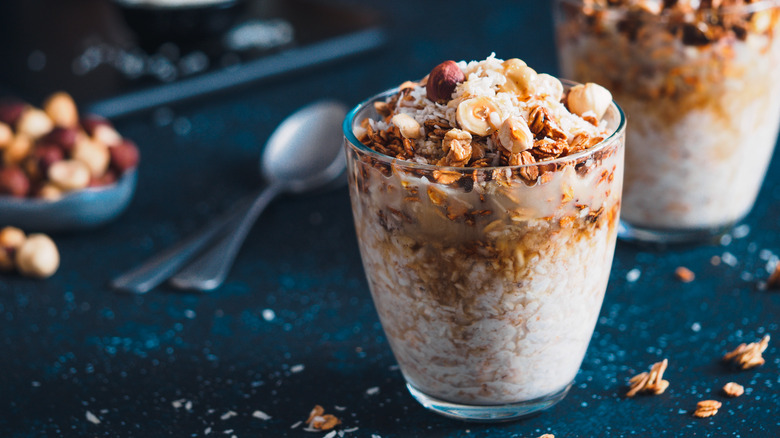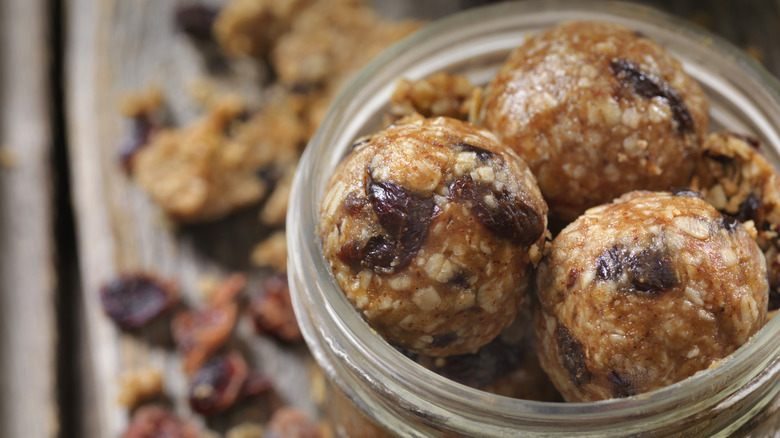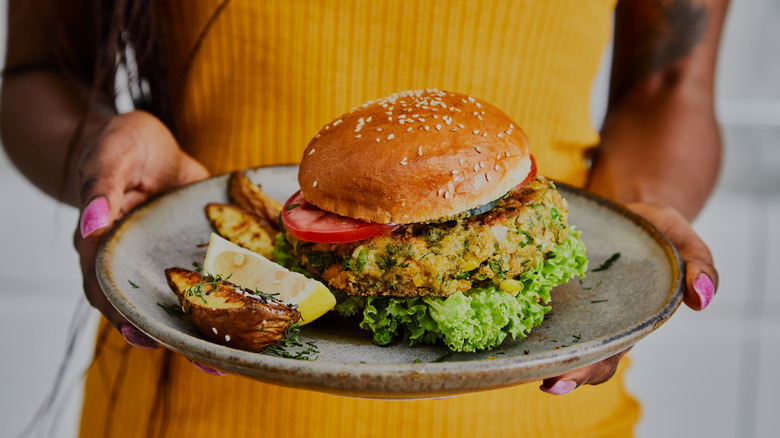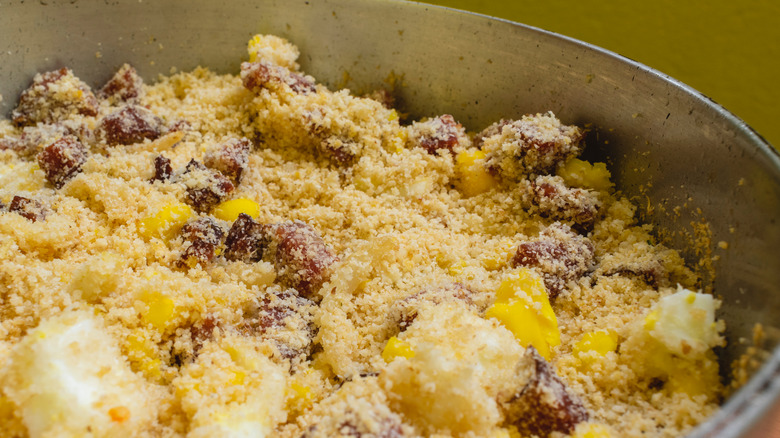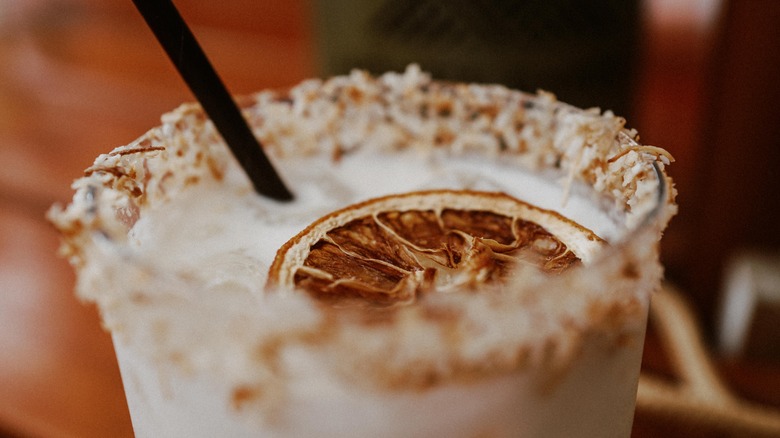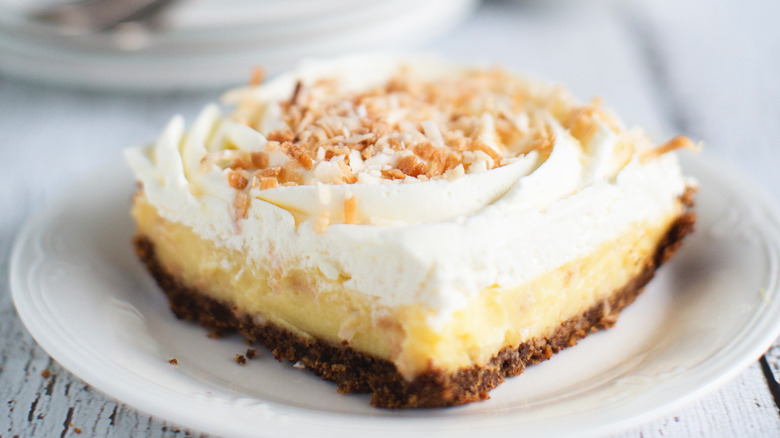13 Best Ways To Use Leftover Coconut Pulp
Coconut milk is a staple in many cultures where coconut trees grow in abundance. It's incredibly creamy, fatty, rich, and absolutely delicious. Commonly used to make curries and soups, coconut milk is pressed from the meaty white flesh of a coconut. But what happens to all of that leftover pulp once you press out the good stuff? Oftentimes, it gets discarded, when there are actually many ways to use leftover coconut pulp in tasty and creative ways.
For those making fresh coconut milk or cream, it's time to start saving your pulp. It can be used for both sweet and savory dishes, and eaten in both its raw and cooked forms. This meaty pulp can add texture, bulk, and fiber to any dish it comes in contact with. Coconut pulp is so versatile it can even be used as a gluten-free flour replacement or a breading for fried fish. At the end of the day, there is no good excuse for tossing it once the cream is squeezed out because every part of the coconut can and should be used for something. Even if you're not into the zero-waste lifestyle, you will want to find out how to enhance your culinary creations with leftover coconut pulp.
Make coconut manna
Ever heard of coconut manna? It's a form of coconut butter that's made from entirely dried coconut flesh, and it's incredibly fatty, decedent, and creamy. Just like butter, manna melts in your mouth but is a healthier, whole-food version of coconut oil containing a lot of fiber. Sometimes, coconut manna is referred to as coconut butter because of its consistency, and can be used like butter, or added to curries, soups, and pretty much any meal to make it creamier.
When coconut manna is made from coconut pulp instead of coconut meat, it is less fatty and slightly less rich. It still has that mild coconut flavor and can add quite a bit of richness to any dish. Because most of the fat has been removed when coconut pulp is strained, it doesn't prevent sticking like butter or coconut oil might to a pan. Make your own by dehydrating or baking coconut pulp, and then blending it with a high-speed blender until creamy.
Add it to homemade granola
For those of you who have gone full hippie and enjoy making your own granola, we hear you. Not only can you add just what you want, but the smell of baking granola can transform a kitchen from a chaotic workspace to a cottage in the mountains. Whether you make your granola with oats, toasted quinoa, nuts, seeds, or dried fruit, there is one other ingredient you should consider adding to bring it to the next level.
Coconut pulp can be mixed right into any granola recipe before it's baked until golden brown. It clings to grains beautifully and becomes fragrant and crispy when baked. It will add to the overall texture of the batch, and have a slightly nutty sweet flavor. In addition, it will help to bulk up the fiber content and create a more filling snack or breakfast. Because it has such a neutral flavor, coconut pulp pairs well with just about any ingredient that you're planning to add, whether you go the peanut and chocolate chip route, or opt for candied ginger and dehydrated pineapple instead. Whichever direction you decide to go, coconut pulp will make a fantastic addition.
Thicken your smoothie
If you're in the school of thought that water and ice cubes deserve no place near smoothies, and that they should be rich, creamy, and decadent then let us introduce you to the best addition to dollop right into the blender. Coconut pulp adds a creamy richness without overdoing it on fat content, as most of the cream and oil has been squeezed or juiced out leaving mostly flavorful fiber behind.
While coconut pulp can be added to any flavor smoothie, consider highlighting it in creamy, tropical-themed smoothies. It's the perfect addition to any plant-based milkshake, alongside non-dairy milk, vanilla extract, and frozen bananas. If you're a fan of blended piña coladas (let's be real, who isn't?) then you must try adding coconut pulp to your next batch to make it ultra creamy and thick. The coconut flavor enhances each sip while adding texture to the thin pineapple juice. Lastly, you can blend coconut pulp with plant-based milk or cow's milk to make a thick cream to top any smoothie with. If not for the incredible flavor and texture, dollop it on for aesthetic appeal.
Turn it into coconut flour in baking
Gluten-free folks have no doubt tried every alternative flour under the sun. From quinoa flour to chickpea flour, the hunt is on to find a tasty replacement for wheat. One flour that stands out above all else is coconut flour, as it makes a delicious addition to baked goods. As coconut is not a grain, you may be wondering what coconut flour is made of. It's made with either the meat or pulp of the coconut.
To make your own, use leftover coconut pulp and bake it in the oven at 120 degrees Fahrenheit for 45 minutes, or until it's completely dehydrated. Then, run it through the food processor to break it up until it becomes fine like almond flour. It will never fully reach the consistency of the baking flour you're used to, but it does have a melt-in-your-mouth texture. Because the pulp doesn't contain a binder like gluten, you'll need to mix it with starches to ensure that your baked goods won't fall apart once cooked.
Make a gluten-free breadcrumb coating
Each and every part of the coconut can be used, so take a beat before throwing any of it away. There are plenty of creative ways to use a whole coconut, including making a bowl out of the shell, using the husk in your garden, drinking the water and the milk, and, of course, saving that pulp. In fact, coconut pulp can be used to make gluten-free breadcrumbs. Just because coconuts are notoriously sweet doesn't mean that coconut pulp only has a place in desserts.
Toast, bake, or dehydrate coconut pulp to get that crunchy texture. For classic breadcrumbs, mix the wet pulp with sea salt, black pepper, dried parsley, and granulated garlic before baking. Coconut pulp has a mild flavor, so any of your favorite seasonings should do the trick. Use these breadcrumbs to coat fish, chicken, or vegetables. Use them to top macaroni and cheese. You'll find that the texture is similar to that of breadcrumbs, but slightly chewier with a mild sweetness.
Save it for a spa day
Now that we've nourished our bodies from the inside out with nutrient-rich coconut pulp, it's time to go skin deep and use it for a spa day. Coconut's themselves are incredible for your skin. The oil can be used as an antibacterial moisturizer and is often used to hydrate the dry ends of brittle hair. But coconut oil isn't the only part of the coconut that should crash your spa day. Use coconut pulp as an all-natural scrub for your face. It's soft enough not to damage your skin but has enough texture to exfoliate the top layer of dead cells.
Simply use the pulp plain, or mix it with your favorite facial ingredients like sugar and salt for a deeper scrub. For sensitive skin, mix with cooked oatmeal and honey, or any facial cleanser you typically use. Let your skin rest between exfoliations, and enjoy glowing, silky smooth skin.
Coat them in chocolate
If you're a chocolate or candy fanatic, then you're no stranger to Mounds, the chocolate-covered coconut bars that are both chewy and melt in your mouth. Well, instead of throwing away that coconut pulp, consider using it to make your very own homemade Mounds bars. Simply mix the pulp in with a sticky sweetener of choice, perhaps maple syrup, simple syrup, or even better, coconut syrup. Be sure to check the consistency and levels of sweetness to be sure they match your liking.
Roll the coconut sugar goop into long bar-like shapes, and freeze them on parchment paper until solid. Next, melt dark chocolate down and dip those little coconut bars right into the pot. Use a fork to roll them around so they are entirely coated, and then remove them to cool. If you want to use tempering like the master chocolatiers to make your outer layer nice and shiny, then you'll want to heat and cool it to specific temperatures to stabilize it. This will help the layer of chocolate to snap when you bite into it, instead of crumbling in your hands.
Mix it into loaded oatmeal
Everyone likes a healthy dose of fiber in the morning, and a great way to get it is through oatmeal. The best oatmeal is loaded to the brim with varying flavors and textures. Classics like toasted nuts, dried and sliced fruits, seeds, and chocolate chips have all been known to make an appearance at breakfast time. Ground flaxseed and chia can help to bulk up the base, but so can the addition of coconut pulp while adding an additional dose of fiber.
Coconut pulp won't change the flavor too much while adding a nice chewy texture to the mix. After all, isn't that everyone's complaint about oatmeal, that it's too mushy? Well, coconut pulp has solved that problem for good. Simply add freshly pressed coconut pulp to your oats before or after cooking them, or top cooked oats with toasted coconut pulp. Coconut pairs beautifully with just about any fruit or nut, but we recommend adding sliced banana to sweeten things up, along with little nuggets of dehydrated ginger. The dynamic duo of oats and coconut pulp should really get things moving for you in the morning, and stick with you throughout the day.
Roll them into energy bites
For working parents on the go, athletes, or anyone who just simply gets hangry a little too often, you are most likely no stranger to protein bars and energy balls. They can be a real lifesaver when the time between meals is just too long, or you've burned off a little more than you're taking in. Typically, there are three major components to these little life-sustaining nuggets. Carbs, fiber, and protein are all essential to ensuring you get that energy boost you need, and that you won't crash immediately after.
A typical staple of these bars is some kind of nut butter because of its easily digested protein. Next, it's important to have some whole carbs like oats. Of course, every energy ball needs a sweetener, which is where mashed dates or date syrup comes in handy. To super-boost your energy bites, either mix them with coconut pulp or use toasted coconut pulp to coat them for easy storage. The chewy and fiber-rich addition will be both delicious and help to create bulk. Enjoy a snack-to-go that's both healthy and flavorful.
Save it for veggie burgers
For those of you who have gone down the veggie burger rabbit hole, then you're well aware that veggie burgers can be made out of much more than just veggies. In fact, grains, nuts, seeds, and even fruit are often welcomed ingredients that can add to the overall consistency, nutrient content, and flavor. Oats, walnuts, and chickpeas are common components of homemade veggie burgers, which help to add a chewy texture and work as binders. A great use for leftover veggie pulp from your juicer is to make veggie burgers out of it. This pulp is not water-dense, so it helps to make a steady burger that's even grill capable.
In the same vein, coconut pulp works just as well in any veggie burger. It adds a subtle sweetness and has a meaty, chewy texture. Be sure to use plenty of seasonings, and to add a binder like chickpea flour or beans, as the pulp will crumble apart on its own.
Add a crunchy topping to savory dishes
Ever heard of toasted coconut bacon bits? Coconut has a similar melt-in-your-mouth texture as freshly cooked bacon and a similar crispy crunch as that crumbly bacon you find on cob and wedge salads. Coconut pulp is even less sweet than coconut flakes and can be seasoned in a way that makes for the perfect savory topping.
Use your hands to mix ingredients like tamari, cumin, chili powder, and garlic powder with your leftover coconut pulp. Spread it out on parchment paper on a baking sheet and cook until the pulp becomes toasty brown and crunchy. Sprinkle it over salads, fish, proteins, roasted vegetable dishes, and soup. This added texture and flavor are not so different from adding a toasted nut or seed topping for some crunch. It has a similar mouthfeel to fried food and is a healthy alternative for those looking to avoid the deep fryer. Mix up the spicing to fit your preference, and to complement the dish best.
Rim a tropical cocktail
There's something special about ordering a fancy drink at a restaurant. Maybe it's the perfect ratio of mixers to booze. Perhaps it's the freshly squeezed fruit juices and mulled herbs. Or maybe it's those fancy glasses and eye-catching garnishes. Let's be honest, we get over-the-moon excited when our Bloody Marys come stacked to the hilt with pickled vegetables, bacon, olives, celery, shrimp tails, and the occasional unique addition like fried chicken legs. Well, there's nothing stopping you from making your cocktails at home restaurant quality.
If you're making fancy cocktails for yourself or your guests, let us introduce you to the best way to rim a tropical drink. Yes, sugar and salt are tasty, but consider adding toasted and sweetened coconut pulp to the rim of your tropical drink. This works well for classic piña coladas, Bahama mamas, coconut margaritas, and painkiller cocktails, but any drink with fruit or coconut undertones will do. In fact, it even goes beautifully with a s'mores-style chocolate martini. Simply mix sugar into your coconut pulp before toasting it, and then use a sticky syrup like maple syrup or chocolate syrup to rim the glass before dipping it into a shallow pan of the toasted and cooled pulp. Use a food processor to break up the cooked pulp if it's sticking together in chunks. Rimming with leftover coconut pulp works well for the kid-friendly virgin versions of the beverages, and fancy coffees.
Use it as a sweet garnish for baked goods
Every baked good deserves a beautiful garnish, and what better way to use leftover coconut pulp than to embellish a baked good? It's likely you've seen coconut cake smeared with white icing and plastered with little curly bits of dehydrated and sweetened coconut meat. The texture is incredible, and it adds so much to the over aesthetic of the dessert, so why let coconut cake have all the fun? There's nothing better than a devilishly sweet dessert that makes a visual statement as well.
Mix your leftover coconut pulp with vanilla extract, a sweetener of choice, and just a tiny dash of salt before toasting it in the oven until it's completely dehydrated. Break it up in the food processor until it's in uniform bits to the size of your liking. These bits stick beautifully to icing, so consider adding them to iced cookies, cakes, and cupcakes. Because of their subtle flavor, you can lay them on thick. For a handheld dessert like cupcakes, simply ice and then dip them into a bowl of the cooled coconut crumble to get an even coating.
